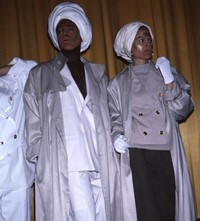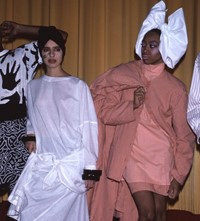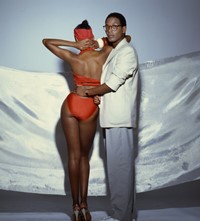A true fashion trailblazer, Willi Smith – who was known as “the designer of the people” – created clothing not for the salon but the street
- TextMiss Rosen
Decades before inclusivity, diversity, visibility and representation became buzzwords du jour, African-American fashion designer and inventor of streetwear Willi Smith (1948-1987) blazed a groundbreaking path to democratise fashion and make it accessible and affordable for people from all walks of life. “I design for no particular age or race, but for someone who is curious about the world,” Smith told Metropolis magazine in 1985.
In 1976, Smith partnered with Laurie Mallet to launch the iconic brand WilliWear, which planted the seeds for a global revolution in fashion that is even more pertinent now, some three decades after his untimely death at the age of 39 from Aids. “Smith pioneered much of what is resonating in fashion today – extensive collaborations between fashion, performance, architecture, graphic design and visual art,” says curator of contemporary design Alexandra Cunningham Cameron, who organized Willi Smith: Street Couture, the designer’s first museum exhibition.
Opening March 13, the exhibition explores Smith’s innovative approach to design, casting, and marketing in a series of photographs, video, design drawings, garments, patterns and ephemera that showcase Smith’s ability to transform clothing into a revolutionary force. Smith valued style over status and used his designs to cross-pollinate ideas about personal freedom that defied constructions of race, gender and class while embracing the multicultural ethos of the street.
Born in Philadelphia to an ironworker and a homemaker who loved clothes, Smith grew up drawing and designing clothes. Smith’s childhood friend, the designer Alvin Bell, told Cunningham Cameron that he and Smith would dream about their future careers. “Bell was inspired by French designers like Yves Saint Laurent and Christian Dior, but Smith found their designs to be detached from everyday needs,” she says. “He told Bell that he strove to be ‘the designer of the people’.”
Smith transformed fashion with his deceptively simple approach to creating everyday “basics” that he referred to as “canvases for the body”. Inspired by military dress, uniforms and workwear, Smith embraced ideas of utility, durable construction and the ease of dressing in predetermined and interchangeable elements on his designs that could be mixed, matched and interpreted by his customers
“Smith was interested in changing fashion from the inside,” Cunningham Cameron says. He trained in fashion illustration at the Philadelphia College of Art before moving to New York to study at Parsons and intern for couturier Arnold Scaasi. “He wanted to create his own path in fashion that made a statement beyond the distinctive form or construction of his garments and that did not rely on a wealthy clientele to support his work. He launched WilliWear to take control of his product and message.”

As an African-American gay man living through the Civil Rights and Gay Liberation Movements of the 1960s and 70s, Smith understood that reducing a person to a single aspect of their identities was far too limiting for himself and his customers. He used his work to question, explore, and transcend any boundaries placed upon them.
“I have it through my head now to give women simple, packaged clothes that adapt to a lifestyle, rich or poor. People really only need a few clothes,” Smith told Women’s Wear Daily in 1972, at a time when the consumer landscape was rapidly changing. Women were becoming a major sector of the workforce, the black middle class was on the rise, and aspirational marketing for luxury goods was heading into the mainstream.
“It was unusual for a designer with mounting celebrity status to speak openly about resisting these increasing patterns of consumption,” Cunningham Cameron says.“But Smith was not anti-commercial, in fact he saw the commercial success of his ‘affordable basics’ to be a sign that he was creating a product that people needed to improve their lives on their own terms.”
Long before collaborations became one of the most desirable forms of cultural currency, WilliWear was skillfully leveraging innovative partnerships with artists, designers and performers like Nam June Pak, Keith Haring and Bill T. Jones to break down social, cultural, and economic boundaries on the runway, in stores, and on the street.
“No other brand or fashion designer was engaging with such wide-ranging multidisciplinary collaborations at the time that intended to take fashion out of its rigid discipline and inject it into film, performance and installation where it commented on the times and reflected broader cultural values rather than fantasy,” Cunningham Cameron says.

“These collaborations were designed for mass awareness. When techno-utopian video artist Juan Downey made a 28-inch monitor work for the Fall 1983 Street Couture runway show, a single channel video was produced to put into stores that carried WilliWear. When the brand commissioned artists like Barbara Kruger, Jenny Holzer, Christo and Robert Rauschenberg to create T-shirts, these weren’t expensive or limited-edition items – they were affordable and industrially produced.”
Smith’s sensibilities were quickly infused into mainstream fashion as his success inspired others to follow his lead. Prescient about the nature of America style, Smith understood just how intertwined consumerism and identity were. In 1982, Smith told Channel 13 News, “when people hear the name Willi Smith, I want them to think that this is a person who cares enough about them that he’s taking the time to design and create and think for them”.
It was a philosophy countless other streetwear designers would soon adopt in a quest to attain the heights that Smith had achieved in his brief, remarkable life.
Willi Smith: Street Couture is on at Cooper Hewitt in New York From March 13 – October 25, 2020. A book of the same name has just been released by Rizzoli.















